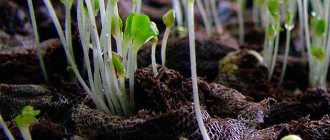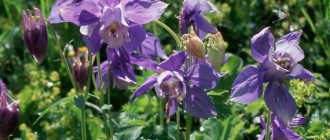If you want to give the area a unique flavor, then plant mallow, which is great for growing from seeds at home.
Dear readers! For you, we have created communities on social networks in which useful articles and interesting ideas are published several times a day! Subscribe and receive useful content in a convenient format!
This is an unpretentious plant, which is also called rose stem.
Mallow (rose rose) is propagated with seeds. They are sown in two ways: seedlings and direct application to the soil. If you follow the technology, the mallow will delight you with flowering in just a few months.
How to determine the time of sowing mallow?
To grow annual stock roses, sowing is carried out from late February to mid-March. There is no need to be afraid of cold weather: mallow is not afraid of lower temperatures.
Biennial seeds are sown in the garden bed from April to the end of May. Pre-winter sowing is carried out in the fall, in October. To avoid seed death, sowing is carried out in October. With spring warming, seeds sown on the eve of winter germinate.
ATTENTION! The flowering of the rose stem depends on the timing of sowing. Bushes grown at home from seedlings will delight the eye already in September. Plants that were planted in the ground in May will produce flower stalks the following year.
General description of the flower
The rose holly is a plant that belongs to the mallow family. To say that this rose is popular in our country is to say nothing. It is adored for its high decorativeness, unpretentiousness in cultivation and a huge variety of species. All of them were obtained by crossing representatives of the genus with each other. The striking difference between the hollyhock rose is its straight, stick-like stem, its height, however, varies. The heart shape is clearly visible on the leaves, there is fluff; it is present on the stem at the beginning of the growing season, after which it becomes smooth.
There can be one or five flowers in one bosom, but the rose is always very beautiful, all strewn with inflorescences. Their shape can be completely different - simple inflorescences, double ones, those reminiscent of carnations, poppies, and, of course, the rose itself. Flowers can be huge - up to 15 cm, and miniature - up to 5 cm in diameter, and located along the stem, like spikelets or in the form of tassels. Planting a hollyhock rose in the garden for the first time is a pleasant event for the gardener, as the flower beds are transformed enormously. From these colors alone you can create ideal compositions.
For information!
Flowers from the mallow family have been known for more than 3 thousand years; it is not surprising that plants are popular not only in our country, but throughout the world - in Africa, America, in the west and east.
How to prepare mallow seeds for sowing
To increase germination, growing from seeds at home requires preliminary preparation of planting material.
Round seeds purchased in a store or separated from achenes are placed in warm water at 45 ºC and left for 12 hours. The seeds are covered with a hard, leathery shell that softens when soaked. This manipulation shortens the period of germination of mallow seeds.
ON A NOTE. When growing, it is advisable to use solutions of growth stimulants Epin, Energen and Fitosporin. Substances accelerate the development of seeds, promote better rooting of seedlings during picking, strengthen the immune system and protect against diseases.
To prepare a working solution for soaking flower seeds, dissolve 4 drops of Epin in 100 ml of water and leave for 18-20 hours. The seed material is also treated with ash, soda, potassium permanganate, hydrogen peroxide and other disinfectants dissolved in water.
How to choose a site for planting
Mallow is not a picky crop. But it has its own requirements for the soil and location. The planting site is selected for the mallow forever until the bush is removed. The fact is that the plant cannot be replanted. An adult bush will not tolerate transplantation and will die. The root system is very powerful, but when transferred to a new place it practically does not take root.
Plant seeds or seedlings in a sunny area. In partial shade, the ball will not grow to its full height, and the color of the flowers will not be as rich as when grown in the sun.
Choose an elevated place so that the roots do not reach groundwater. Or they make a drainage of 15-20 cm.
Since the plant is tall, the wind can break it. It is better to choose a place where there are no drafts and frequent winds.
Soil selection
The optimal soil for growth and flowering is loamy soil. The loams should not be very clayey, otherwise they will become heavy, which is bad for the root system of the flower. The soil may be poor, but flowering will be abundant even on such soil. The main thing on poor lands is regular fertilizing.
The soil needs to be light, but acidity is not particularly important. It is desirable that the soil has a neutral Ph, but flowering will occur in both acidic and alkaline soil.
Soil preparation
Even unpretentious mallow needs to prepare a place where it will grow. The area needs to be dug up, preferably deeply, since the roots grow deeper. Then add compost humus, manure and sand. Sand is needed to make the substrate light and drained. Each component is taken in equal parts.
When to sow mallow for seedlings in 2022 according to the Lunar calendar?
The right thing is done by flower growers who, when growing at home, check the timing of sowing crops with the dates indicated in the Lunar calendar. The energy of suitable/unsuitable days affects the germination and development of stock rose seedlings.
Favorable days for sowing mallow in 2022 (by month)
| In January | In February | In March | In April | In May | In June | |
| Preparation/Soaking | 21, 22, 26, 27 | from 12 to 14, 17-24 | 12-14,17, 18, 23-24 | 18-19, 26-28 | 20, 22, 24, 25 | 21, 22, 23, 29-30 |
| Sowing | 3-9, 16-17, 20-23, 25-27, 30-31 | 4, 7-9, 12-14, 7-25 | 3, 5, 8, 14-22, 24-27 | 3, 5, 8-9, 13, 15-22, 24-26 | 2, 5-7, 12-17, 19-22, 24, 25, 28 and 29 | 2, 3, 6-8, 15-26, 29, 30 |
| Picking / Transplanting | 5-9, 16-17, 21-23, 25-27 | 2-5, 7-9, 20-24 | 1, 3-5, 8, 15, 19 and 28 | 1, 3, 5, 8, 9, 13, 15-19, 28 | 1, 2, 5, 13, 15, 16,17, 20, 24, 28-29 | 2-3, 6-8, 11-13, 6, 21-23, 29-30 |
Bad days to plant mallow seeds in 2021
| In January | In February | In March | In April | In May | In June | |
| Do not carry out cultivation robots | 2, 3, 10, 13-15, 28 and 31 | 10, 11, 21, 22, 26 and 27 | 9-11, 13, 19-21, 25, 26, 28 | 3-4, 12, 15-17, 20-22, 27 and 30 | 3, 4, 8-9, 11, 24, 30 and 31 | 1, 4-5, 10, 14-15, 24, 27-28 |
Conditions for crops
The box with the crops is covered with a transparent film. In greenhouse conditions, the seeds will hatch faster. The covering material is removed every day for 10-15 minutes. This is necessary to ventilate the mini-greenhouse.
Condensation forms on the walls of the container and the film. It must be wiped with a dry cloth to avoid the appearance of putrefactive microorganisms. Otherwise, all crops may die.
When to plant depending on the region?
Mallow is cultivated in Russia, Ukraine and Uzbekistan. As a medicinal, fodder and ornamental plant, mallow is grown in areas with warm and cold climates, as well as in the central zone.
Mid latitudes
In the middle zone, stock roses are planted in open ground in spring and autumn. To preserve flowers, they are covered in a greenhouse, placed in a cellar or in cold storage. These measures will help the mallow to safely survive the frosts.
Southern regions
Given the cold-resistant characteristics of the flower, during the winter months it is left to overwinter in the garden bed. In October-November, a mulch layer is laid at the base. This is enough for crops growing in warm areas.
North
Residents of the region have to give up growing mallow. In the harsh northern climate, it loses its winter hardiness. But some species adapt and grow in cold conditions with additional shelter and insulation. You can use spruce branches, spunbond, film or agrofibre. These measures will protect the mallow and help it survive the cold.
Beneficial properties of mallow
This is a plant that herbalists have been familiar with for a long time. Using a tincture of the flower, you can cure inflammation in the stomach or intestinal disorders. Hot baths prepared with wild mallow leaves help shrink an enlarged spleen.
Forest mallow is also included in the breast collection. Decoctions of mallow flowers will help cope with allergic manifestations on human skin and are excellent in healing open wounds and burns.
Mallow has the following properties:
- expectorants;
- anti-inflammatory;
- softening;
- general strengthening.
In folk medicine, all parts of the plant are used for treatment, while state medicine uses only the vegetative mass of the flower. Dry the collected parts in the shade, in a well-ventilated area. It must be stored in containers with a signed date of collection.
Although malva-based drugs are considered not dangerous, they cannot be used without consulting a doctor. Since there is always the possibility of personal intolerance to this plant by a person.
Beautiful bright flowers for a flower bed look great when decorating a site. They are planted in a group in the center or near the wall of the house. These tall plants can be used to brighten up unsightly yard structures.
This beautiful plant, which has been grown for several centuries, is worth planting near your home. It will fit perfectly into the landscape design and will be absolutely maintenance-free. And if necessary, it will help improve your health.
All the secrets of growing mallow
Read all about garden geranium here.
- Perennial flowers for the garden
- Photos of beautiful flowers
- Lobelia - planting and care
- Cineraria - smoky beauty
- We decorate the flowerbed with decorative onions “Allium”
- Aquilegia - a magical, unpretentious flower
- Petunia is the most unpretentious flower
- Early spring flowers in the garden
- Pansies - delicate spring flowers
- Flowers for a flower bed are the best (100 photos)
- Lavender is a great decoration for the garden
- Sedum - planting and care
Planting mallow seeds step by step
When growing at home using seedlings, prepare a container (container, tray, plastic cups) and fill it with nutritious soil mixture. Add a universal flower substrate, sand, and Vermiculite.
You can use a mixture of coconut substrate, organic matter (humus collected in the fall), ash, or plant it in peat pots.
Mallow seeds are large and are easy to distribute over the soil surface. The contents of the container are leveled and slightly compacted. This is done so that there are no voids in the ground and the seeds do not fall deeper than they should.
Next, the sowing is carried out step by step:
- The earth is warmed up and disinfected.
- Moisten generously with a spray bottle. The water should be warm, so the seed will germinate faster.
- The mallow seed material is laid out on the surface of the soil, pressing lightly with your fingers. Seeds need deeper planting (1.5-2 cm).
- The seeds are covered with a layer of soil mixture on top, covered with a lid or film in order to create a microclimate and a greenhouse effect in the tray.
- Place in a warm, bright place with an optimal temperature of 20-23 C, leave for germination.
If the air in the room is heated to 18-22 ºС, it will take about 2 weeks for germination at home. In a cool apartment, the trays are watered with hot water, then covered with thick canvas or a blanket and kept until the seeds hatch.
There are other ways to grow mallow seeds at home. Savvy gardeners have come up with an alternative technique. Its peculiarity is that the seeds germinate not in the soil, but on a damp sponge without a soil environment. After some time, the seeds that have the beginnings of roots are placed in a pot. Place in a warm, dark place and wrap up.
Unsprouted specimens are thrown away. This simplest technique allows you to get rid of non-viable empty seeds. Only those specimens that have opened and formed a root are placed in the soil mixture. Mallow crops are placed on a radiator, which makes it possible to obtain seedlings in a short time.
PECULIARITY! Plants are planted in groups, so it makes sense to put 3-5 seeds in a jar or glass, and then simply roll them over with the ground without damaging the thread-like roots.
Description and features of mallow
The plants have erect, powerful stems on which there are rounded leaves, the edges of which have grooves. The lower leaf blades are much larger than those located at the top. About 15 shoots are formed on each bush.
The height of mallow, which is planted as seedlings, varies depending on the type and variety. It ranges from 80 cm to 2 m.
The flowers are located in the axils of the leaf blades and are fused at the base. The top of the bud is split. The diameter of the flowers is 5-15 cm.
There are different types of mallow, the cultivation of which interests gardeners. As for varieties, breeders have tried to create a huge variety. The buds differ not only in size, but also in color palette. Eat:
- white and pink;
- red and burgundy;
- black and striped.
In addition, the buds are simple, semi-double and double. So there is plenty to choose from.
Types of mallow
The main types of mallow grown by Russian flower growers.
- Annual. Height - about 130 cm. Flowers are simple, pale pink.
- Hybrid mallow or wild mallow. The main method of cultivation is by seeds in an annual or biennial crop. The plant is tall (up to 2 m), with abundant flowering throughout the growing season. The buds, depending on the variety, are pink, red, white.
- Musk mallow. It is a perennial crop; the main method of cultivation is by seeds. The flowers are white or pink, almost 6 cm in diameter.
- Mallow whorled. It grows wild in Siberia. The annual plant grows up to 2 m. The buds are white or pink.
- Rose-stock. Growing in annual, biennial and perennial crops. Mallow is very tall, with proper agricultural technology it reaches 250 cm. The color palette of the buds is very diverse; they can be represented by double flowers of different shades:
- white and yellow;
- red and pink;
- purple-lilac and inky.
Growing stockrose has recently become fashionable. Moreover, the variety of varieties allows you to make a choice.
How to care for mallow seedlings, any tricks?
Experienced amateur gardeners are ready to share their secrets for caring for mallow and its seedlings at home.
The mallow seeds have sprouted, what to do next?
A week after sowing, the disc-shaped mallow seeds hatch and germinate. Now they need sunlight (additional illumination by a lamp), watering and temperature control (from 20 to 23 ºС). In a month and a half, the seedlings will get stronger and grow.
The next important point when growing rose stems at home is picking. It is started when two true sheets appear. There is no need to rush when planting mallow seedlings in a permanent place. Return frosts can damage it.
How to feed flower seedlings
Picked ornamental plants are fed after they become stronger, otherwise they can be damaged. It is advisable to start feeding the bushes no earlier than in a week.
If the soil is fertile and filled with nutrients, it is enough to feed the mallow once with complex mineral fertilizer according to the instructions.
Repeated feeding of mallow is carried out during the period of preparation for flowering. Having noticed flower stalks (around June), potassium-phosphorus fertilizers are applied.
Plant picking rules
After waiting for the heat to settle, you can begin diving. If mallow seedlings grew in individual containers or cassettes, they are handled with a clod of earth, practically without injuring the root.
If the seedlings were grown in a common tray, the soil should first be moistened so as not to damage the root. Next, everything is done step by step in accordance with the mini-instructions:
- Turn the container over, carefully remove the seedlings and very carefully separate the seedlings from each other. An accidentally torn piece of root will not cause much damage: the cells of the root system are activated, and the root will become more powerful.
- In the ground on the territory of the garden bed, depressions are made into which the formed rosettes of mallow are placed.
- The ground around the plants is pressed down and mulched with rotted sawdust, straw, hay, humus, etc.
Water and leave. Further care for hollyhocks consists of regular weeding and loosening.
Is it possible to immediately sow seeds in open ground?
Planting mallow seeds in open ground eliminates the hassle with seedlings. If you don’t want to see flowers this year, then sowing seedlings can be ignored. Using the seedless method, seed material is introduced into open ground. This is done no earlier than in May-June.
Later, rosettes of leaves are formed, they grow and turn green all summer until the onset of winter. But the lush rocking inflorescences of the mallow bloom only the next year. This method has one advantage: the flower stalks are rich and luxurious.
In order for the annual mallow to throw out its color by the summer of the first year, it makes no sense to add seeds directly to the garden bed: the soil is not ready, the seeds will not sprout. For this, there is a seedling method for growing at home.
Judging by the observations of flower growers, when grown at home by seedlings (spring planting), the plant forms one, not very lush peduncle. Therefore, summer planting is more preferable for lovers of beautiful mallow, and there will be more stems on the plant. You can sow a stock rose in a garden bed before winter.
The seeds are kept under the snow until spring. Planting in the fall has several advantages: simplicity, early summer flowering. The introduction of seeds into the soil is accompanied by further mulching. Features of care include covering with jars for protection from frost and measures against rotting during the thaw.
When to plant seedlings in open ground?
Annual mallow is moved to open ground in mid-May, when the threat of return spring frosts has passed. But cold snaps are not scary for young bushes either: the perennial is a cold-resistant crop. The time for planting comes in August-September.
Disease and pest control
Mallow is a very resistant crop to both pests and diseases. But in order to reduce the risk of such problems, it is important not to give up on prevention and follow the basic rules for caring for this plant.
It is especially important to monitor watering, since excessive watering can lead to various pathologies:
- spotting;
- stem cancer;
- powdery mildew.
When the first signs of disease appear, for example, darkening of the stems, wilting or falling leaves, the flowers are sprayed with suitable compounds - the choice depends on the disease. To destroy insect pests, because the mallow is especially often affected by spider mites, the plants are treated with:
- "Fitoverm";
- "Fufanon."
Planting and growing mallow from seeds is accessible even to novice gardeners. Only a few points are important here: choose a suitable variety, prepare planting material, seeds, soil mixture. The plant itself is unpretentious and does not require special care.
Where is the best place to plant flowers?
Picturesque flowers grow well in flower beds and look great as a hedge. They are planted mainly in groups in the garden. Ridges exposed to the winds are not suitable for hollyhocks.
Tall stems need support. They require tying, otherwise they may break in gusts of wind. It’s good if it is possible to secure the hollyhocks on stakes.
Ideally, hollyhocks are planted in an area along fences. The fence performs a 2 in 1 function: it defines the territory and is used as a trellis for tall hollyhocks. There is an opinion that it is contraindicated for hollyhocks to be near a metal fence due to rust damage. But this is a myth: the underside of the leaves is occupied by the fungus that causes the disease.
Application in garden design
The use of mallow in garden design is so wide that it can be considered irreplaceable.
It is used:
- along hedges, walls, fences;
- in the background of any flower arrangement;
- for framing entrance groups, gates;
- on mixborders;
- as borders;
- in bouquet planting;
- in soliter planting;
- to divide the space into zones, in combination with other tall plants, such as sunflowers.
Garden decor
How to care for mallow in open ground
When the mallows kept in a container at home have formed three leaves, they should be thinned out with indentations of 2-3 cm. The grown, strengthened rosettes are gradually accustomed to other conditions.
Mallow seedlings are hardened off outdoors for several hours. The bushes should be moved to a permanent place from May to June, placing groups of seedlings at a distance of 25 to 50 cm. The row spacing is mulched and regularly moistened.
Watering is accompanied by loosening and removing weeds. During the budding period, mallows are fed with complex fertilizers with a predominance of nitrogen. For the sake of intensive flowering, dried buds are removed.
NOTE! Mallow that has been growing for a year can be turned into a perennial. To do this, after flowering, cut off all flower stalks.
When will the shoots appear?
Under favorable conditions, mallow seeds hatch quickly. Shoots appear in 8-12 days. When all the seeds have sprouted, the film is gradually removed from the box. On the first day, the container is released from cover for 1 hour, on the second - for 2 hours. From the third day the film is removed completely. Further development of plants will occur at room temperature without additional insulation.
What conditions are needed in open ground?
The soil on the site should be loose, light and fertile, with an admixture of sand. The clay structure is not suitable for the growth of mallow. If the land is depleted, it is enriched before planting or mulched with rotted manure.
The beds should not have lowlands or depressions in which water usually accumulates and stagnates. It has a detrimental effect on the plant. Light-loving mallow tolerates shade, but the petals may lose their brightness. It is good if the plot is inaccessible to winds and drafts.
How to water a plant
In hot weather the flower feels fine. Water it not very often, but abundantly. It is better to do this early in the morning or in the evening, using water heated in the sun. You should not overwater young sprouts; they do not like excess moisture.
In dry, hot weather, flowering hollyhocks require abundant watering. It must be remembered that waterlogging is undesirable: stagnation of water is detrimental to the rose stem. Weeding and loosening - this is the minimum that mallow needs.
Features of flower feeding
The beauty and luxurious appearance of mallow depends on a sufficient amount of nutrients in the soil. The effect of nitrogen-containing fertilizers affects the growth rate of mallow, its development and resistance to disease.
To form full buds and abundant flowering, mallows require complex fertilizer. Additionally, mallows need to be fed with weak solutions of potassium and phosphorus. Weak solutions of elements are used from the beginning of summer and processed once every 3-4 weeks.
Possible problems during cultivation
If there is an infection, drying out of the leaf or a change in the color of the green part, the gardener should think about his attitude towards the plant.
First of all, the flower is examined to identify the cause of the “disease.” After which they begin treatment or work on mistakes. After all, the appearance of problems with the crop is the fault of the grower.
You can avoid additional time and material investments if you pay attention to the following:
- It is worth choosing a landing site taking into account some nuances. So mallow is not planted in shaded, damp areas. The wind should not disturb the plant. Lack of lighting harms the decorative effect and color of the buds.
- Soil moisture is regulated according to weather conditions. Excessive watering - rotting of the root system. Watering occurs as needed. If there is heavy rain, then you cannot irrigate. During drought, the frequency of the procedure reaches 2 times a week. Check the soil first.
- The place for permanent “residence” of the mallow should be on a hill to prevent excessive amounts of water during rainy summers.
- In winter, it is necessary to cover the flower to prevent the root from freezing.
The beauty of mallow and its long flowering depends entirely on the correct approach of the grower. Therefore, despite the unpretentiousness and undemanding nature of the plant, agricultural technology is fully observed.
Interesting Facts
Since ancient times, magical properties have been attributed to this flower. Therefore, they planted her at the gate, near the well, near the fence. The ancestors believed that she protected the farmstead, the home and the people in it.
Mallow is a close relative of the medicinal marshmallow, which treats coughs, inflammation, relieves pain, and is used to remove kidney stones.
Decades ago, children playing in the yard would pluck the green buds from the mallow stems and chew them. Scientists have long proven that rose stock has high feeding qualities. Mallow has more protein than soybeans.
The best varieties
Despite the species diversity of plants of this family, a limited number of varieties are grown in plots. The most beloved by flower growers, professionals and amateurs, are the following.
Table. Descriptions of mallow varieties.
| Variety | Characteristics |
| Mallow pink | This perennial plant is called Alcea rosea in Latin. Although it can grow in one place for years, pink mallow is grown in cultivation as a one- or two-year-old plant. One of the tallest representatives of mallows - it can reach a height of two and a half meters. The name does not limit the color range - the flowers can be, in addition to pink, almost any color from the red-blue-violet range. Pink mallow blooms in its second year. Flowering period is July-September. Can be with simple and double flowers. |
| Mallow wrinkled | Of course, this is a close relative of the pink mallow, only wild. However, it has already become so “cultivated” that it will soon displace other species from gardens. It is distinguished by its special unpretentiousness and resistance to cold. He is also tall – about two meters. And huge, condensed milk-colored, corrugated flowers. |
| Musk mallow | This type of mallow is given its name because it has a wonderful, strong, memorable aroma (it is also called nutmeg). Other types smell less intensely or have almost no smell. In addition, this plant is compact, growing up to a meter. At the same time, it has quite large flowers up to five centimeters. The flowers are densely arranged, and the bush looks very elegant. |
| Malva woodland | It is also grown in gardens and vegetable gardens, in flower beds, and as an ornamental plant. In addition to being decorative, it also has numerous medicinal properties. Grows up to one and a half meters. Blooms all summer long. The flowers are small and delicate. This species is the most heat-loving, therefore it is most often grown as an annual. |
| Mallow zebrina | A direct relative of the forest species mallow. They are even similar in appearance, but zebrina is much larger in terms of stem height and flower parameters. In addition, it is resistant to cold, disease, and is grown as a perennial. |
| Terry mallow | Amazes with its magnificence. Reminds me of a mixture of rose and lush carnation. It can grow in height from 75 to 200 cm. There are many terry varieties of various colors, mostly all one color. This species is more capricious than a plant with simple flowers. To maintain its decorative appearance, it requires careful cosmetic care. |
| Mallow garland | It really looks like a garland - the flowers are so often arranged on the stem. Mostly terry types, but there can also be simple ones. The height of the stem grows to about 180 cm. It is a biennial plant. |
Mallow grows naturally from North America to Asia. This plant existed in Ancient Egypt - its healing properties were described in the treatises of Hippocrates. The original mallow flowers have always served as inspiration for artists and poets. And it rightfully occupies a leading place in gardens, standing out among thousands of species of various flowering plants.
Terry stockrose - the queen of the garden
Answers to frequently asked questions
Why are the seedlings not friendly, some of the seeds have sprouted, others continue to sprout?
The problem is a poorly prepared soil mixture. It needed to be steamed and the seeds soaked. In addition, seedlings need warmth.
Why do seedlings droop and fall?
This happens due to thickening. Young sprouts fight for a place under the sun (or lamp). The cause is eliminated by thinning, but the stems are not pulled out, but pinched at the soil level.
Why do the sprouts stretch out?
They become thinner and lean to the sides. The reason is insufficient lighting, too warm a room and waterlogging of the soil. To correct the situation, the seedlings are switched to infrequent watering (once every 3-4 days) and make sure that the water is warm (from +18 to +20°C).
Why do mallow seedlings wither and die?
Due to the dry soil, they receive little moisture. Wilting begins with the lower pair of leaves. Their curling indicates the presence of fungal spores or pests.
The main thing is to notice the disorder, eliminate the cause in time and provide the flowers with proper care. And they will reward you with beauty that is pleasing to the eye.
Plant care
A pleasant surprise for a summer resident who has taken the time to figure out how to grow mallow from seeds and do this difficult work will be the fact that caring for the plant is not at all difficult. It's not capricious at all. But it still needs some care.
Of course, an important fact is watering. In general, mallow can receive water from great depths thanks to its powerful, long root. But in dry times, moistening the soil will be quite useful, especially if you notice that the leaves are starting to wilt - a sure sign of lack of water.
Also, do not forget about timely weeding and loosening of the soil. The latter is most relevant when growing on clay soils - it is difficult for air to pass through compacted, heavy soil to the roots, which will affect the development of the plant.
It is advisable to remove faded flowers immediately to make room for new ones. Well, you shouldn’t forget about protection from the wind - by setting up a small fence of several sticks or wire, you can prevent the stems from breaking even with fairly strong gusts.
Variety of varieties of hollyhock roses
Mallow has always had a special place in village front gardens; it is rare for a garden to do without a slender beauty. Planting mallow in front of windows was considered the same tradition as making rich, unusual frames. Then there was not such a choice of tall perennials as now, which could boast of a slender figure and tall stature. With the help of mallow they decorated the walls of the barn, the foundation and rickety fences. Often, mallow was planted outside the outskirts. This was done not so much with the goal of covering up the unsightly fence and showing off, but with care for the plant itself. We will talk about this in the article a little later.
Until modern selection made a powerful breakthrough, mallow was just a mallow, not a hollyhock, and, of course, looked much simpler. She had simple large flowers in white, crimson and pink. Now among the varieties of hollyhock roses there are flowers of lemon, bright yellow and pure red tones. There are terry, simple and even terry with cut petals, two-color varieties. As they say, if you don’t want to, you’ll put him in jail!
The varieties also differ slightly in height. True, there are no dwarf ones, but there are ones from a meter and above. As for the color palette of hollyhock roses, all the colors of the rainbow are present, including even almost black and purple. Unless there is no sky blue yet.











